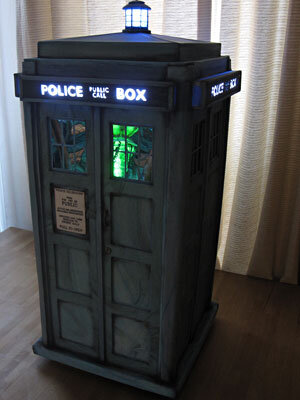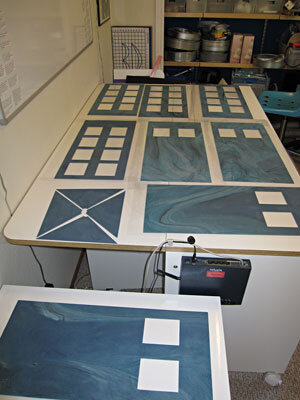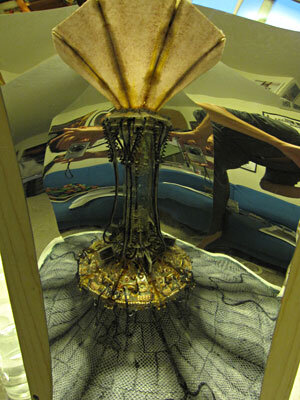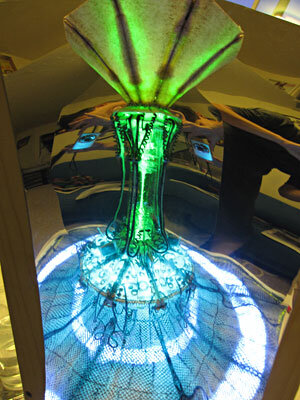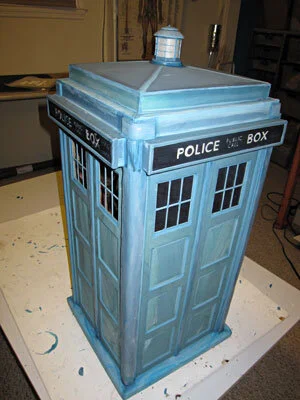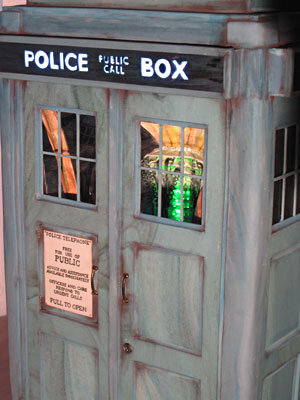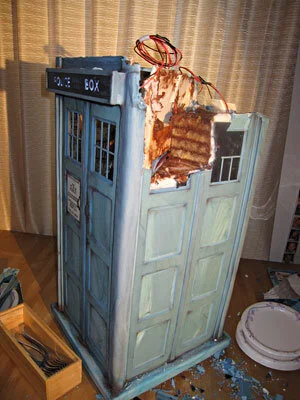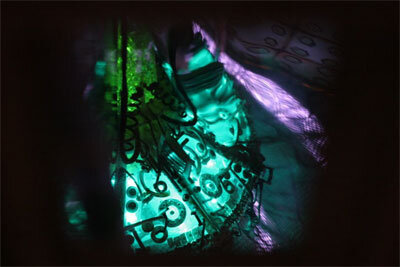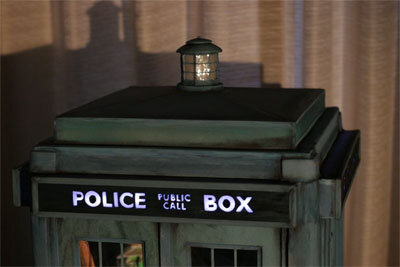TARDIS Cake
It's a TARDIS! It's bigger on the inside! It's two feet tall (quarter scale)! And aside from the lights, everything you see is edible.
I love Dr. Who. Just a few weeks ago my sister-in-law and I waited in line for five hours to get good seats at the Dr. Who panel at Comic-Con. Totally worth it!
Since I would have to be a Time Lord to make a Tardis cake that could actually go anywhere in time and space, I decided to do the next best thing - make a Tardis cake that's bigger on the inside. Or at least appears to be. Like I said, I'm not a Time Lord. I chose to go with the new Tardis interior because, as it is both more organic and more interestingly illuminated than any previous Tardis interior, I thought it would be the most visually effective.
First I had to figure out the best way to create the illusion of a more spacious interior. I tried to consult the internet about optical illusions, but didn't find anything helpful, so I went with old fashioned trial and error. I played around with a lot of different configurations, eventually settling on two convex mirrors arranged at about a 45 degree angle. To get the curve I wanted, I used flexible carnival mirror, glued onto my custom made wood and mat board form.
Next, in order to illuminate the inside of the Tardis and the "Police Box" signs on the outside, I needed to learn at least a little bit about electronics. So I ordered a DIY Electronics Kit from the MakerShed that was really sort of geared for pre-teens, but it was also very helpful. Armed with new-found knowledge of resistors and LEDs, I trolled the internet for the best deals and ordered a total of 385 LEDs in blue, aqua, green, yellow, white, and flashing white. They didn't all make it into the cake, but I did wind up using enough of them that I used seven nine-volt batteries to power them. I embedded these batteries into a plywood base and mounted the mirrors.
With my structure in place, it was time to start making gum paste pieces. The exterior required fifty-two separate pieces of gum paste - two for the panels on each of the four sides plus one inward-facing panel for the side that looked into the interior and three to back the windows on the other three sides, six for each of the four "Police Box" signs (some of which were quite tedious, as I had to painstakingly cut out the words to let the light through), and sixteen for the roof. Later I needed an additional seventy-two pieces of gum paste for the window frames and mullions. I went with a grey-blue marbled effect because I thought it would look more convincing and more interesting than a uniform color field.
To make the interior I started with a gum paste floor with cutouts to let the light through from all the white LEDs embedded in the base. In order to enhance the illusion of interior space and elevate the bottom of the central console sufficiently to make it easily visible through the windows, I gave the floor a serpentine curve, supported by gum paste struts. Then I stuck a layer of rice paper to the top of the gum paste floor and painted it dark grey with food coloring. On top of this I piped grey royal icing expanded steel. It went pretty quickly, because I got a lot of practice making royal icing expanded steel when I was making the Demolition Cake. To give it a nice sheen, I went over it with some silver luster dust.
Now it was time to make the control console. Fortunately, thanks to the mirrors, I only needed to make one eighth of it. The console structure is gum paste and sheet gelatin, assembled around blue, green, and aqua LEDs and attached to the mirrors with clear piping gel. Then I had a good time sticking on a myriad of gum paste and royal icing levers, dials, cables, monitors, etc. At times the mirrors made things a little difficult because it was sometimes hard to remember which was the real console and which was the reflection. Liberal use of silver, bronze, and gold luster dust made everything nice and shiny.
With the interior finished, I assembled the exterior gum paste pieces, adding the royal icing molding around the perimeter of each recessed panel, and installing the window mullions and backing.
It was at this point in the process that we decided that we really should schedule a party so that we would have something to do with this cake when it was finished. Fortunately, we have a lot of nerd friends, so we soon had about forty positive rsvps to our evite. It was also at this point in the process that I took some time off to go to Comic-Con and then on a family trip to Colorado, so my gum paste pieces had a long time to thoroughly dry. This was definitely an advantage, because it would have been very hard to assemble the cake with anything less than 100% dry gum paste and because the pieces were so large that they did require some significant drying time.
A week before the party I began assembling the exterior, beginning by putting together the "Police Box" signs around my strings of white LEDs. I backed the cutout letters with rice paper, both to diffuse the light and so that I could stick the free-floating interior pieces of the O's, P's, A's, and B's to the rice paper.
Because of the mirrors and the interior space only a little less than half of the interior was actually going to be made of cake. This meant that I could install two of the four sides prior to baking any cake and even attach and solder their respective "Police Box" signs.
Three days before the party I baked the cake. We decided to go with a banana cake with chocolate buttercream icing because, to quote the Doctor, "You should always bring a banana to a party. Bananas are good." I needed a total of eight two inch tall, ten inch square cakes. Of the eight cakes, seven of them were cut in half on the diagonal and stacked in the body of the Tardis. The last cake was reserved for the square top section.
With the cakes in place, I covered them with a layer of fondant, to prevent the gum paste exterior pieces from coming into contact with the buttercream, which would moisten, soften, and weaken the gum paste. Then I was able to install the last two side pieces and their respective "Police Box" signs.
I put the top section together separately, carving the slanted roof, covering it with fondant, and then assembling the gum paste pieces around it with royal icing. I left a hole through the middle, so that I could run blinking LEDs through it for the light on top. Once the top section was in place, my Tardis really started to look like a complete piece, but it still needed a lot a detail work.
I used fondant rather than gum paste to cover the base and for the trim on the corners and in the center of each side panel because some of them needed to be relatively thick, which is easier to accomplish with fondant. I did use gum paste, however, for the thin strips of molding around the perimeter of each "Police Box" sign.
To make the little light on top, I wrapped rice paper around gum paste circles, then put panels of sheet gelatin on top of that, followed by gum paste trim and royal icing mullions. The curved top is gum paste dried over Styrofoam balls.
With all the major features in place, I went over the entire structure with royal icing smoothed with a damp paintbrush, to hide unwanted seams and fill in a few gaps. Then, to give it that distressed look of a vehicle that's been to the end of the universe and back again, I went into all the corners with some black powdered food coloring on a soft paintbrush.
To make the sign for the front of the Tardis, I blew up an image of it to the correct size and then essentially made some edible transfer paper by coating the back with black powdered food coloring. I put this on top of a dry white piece of gum paste and traced all the letters with a stylus to transfer the text onto the gum paste below. Then I painted over the letters with black paste color.
The finishing touches were the royal icing handles, hinges, and tacks to hold on the sign, and the gum paste lock.
Carrying the cake to the table for the party was a bit stressful and difficult, as it probably weighed fifty pounds and all of the weight was in one half of the cake. Part of me was convinced that, after literally months of planning and building, I was going to drop it at the penultimate moment. But actually the move went perfectly smoothly. I got my brother-in-law to help me and he even bravely volunteered to carry the heavy end.
I'm really pleased with the way this one came out, maybe more so than any cake I've ever made before. Please note that, with the exception of the mirrors, the electronics, and the wooden base and dowels and foam core separators that would needed in any cake this size, it is entirely edible. (And if anyone knows how to make an edible mirror, please let me know.) It's hard to capture the "bigger-on-the-inside" effect in a photo, but I do think it was pretty darned successful. By an odd coincidence, Cake Wrecks (one of my favorite websites) did a Dr. Who post on the very same day that we had our party, so I immediately sent them photos of the cake, mere hours after it had been consumed, and they very kindly posted it right away!
For hours after we attended the Dr. Who panel at Comic-Con, my sister-in-law and I were all a-twitter about how awesome it was; now I still kind of feel that way about this cake.

